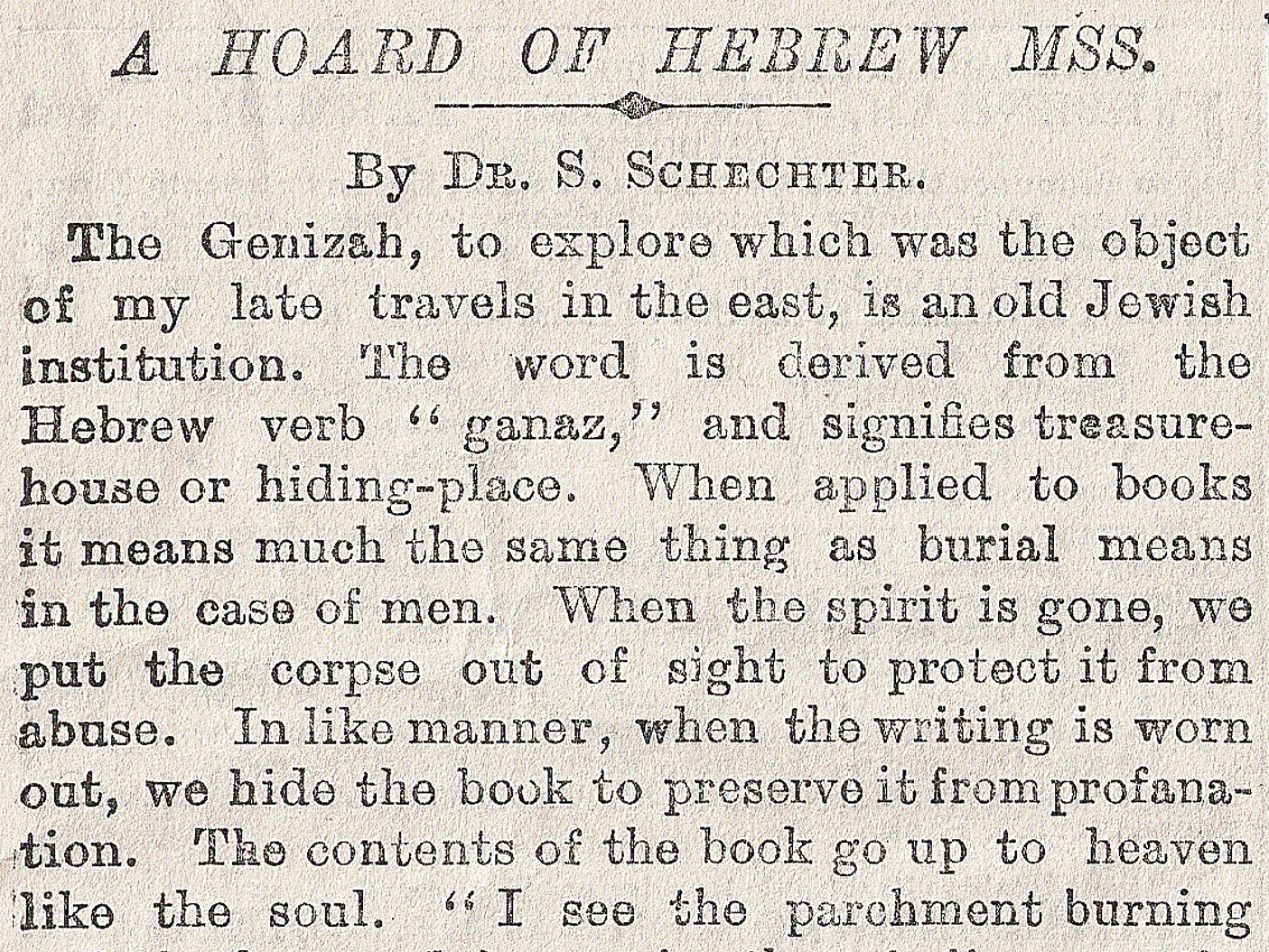3rd August: Schechter's announcement in the Times

On his return to Britain, Solomon Schechter described his ‘pilgrimage’ to the Genizah in the Ben Ezra Synagogue. His account, an article entitled ‘A Hoard of Hebrew Mss’, was published in The Times 124 years ago, on 3 August, 1897.
After introducing the concept of a Genizah to the British public:
‘The Genizah of the old Jewish community... represents a combination of sacred lumber-room and secular record office.’
Schechter outlines his motivation for visiting Cairo and thanks his patrons:
‘especially Dr. Taylor, the Master of St. John’s College… the enlightened generosity of this great student and patron of Hebrew literature’
On arriving in Egypt, Schechter worried that much of its history had been lost:
‘Now that the sources of the Nile are being visited by bicycles, there is little fresh to be said about Cairo and Alexandria. The latter, at which I landed, is particularly disappointing to the Jewish student... Cairo is not more promising at the first glance that one gets on the way from the station to the hotel. Everything in it calculated to satisfy the needs of the European tourist is sadly modern, and my heart sank within me when I reflected that this was the place whence I was expected to return laden with spoils, the age of which would command respect even in our ancient seats of learning. However, I felt reassured after a brief interview whith the Rev. Aaron Bensimon, the Grand Rabbi of Cairo, to whom I had an introduction from the Chief Rabbi, the Very Rev. Dr. Hermann Adler. From him I soon learnt that Old Cairo would be the proper field of my activity, a place old enough to enjoy the respect even of a resident of Cambridge.’
Schechter visits the synagogue with the rabbi:
‘We left our carriage somewhere in the neighbourhood of the “Fortress of Babylon,” whence the Rabbi directed his steps to the so-called Synagogue of Ezra the Scribe.’
And is shown the Genizah.
‘The Genizah, which probably always formed an integral part of the synagogue, is now situated at the end of the gallery, presenting the appearance of a sort of windowless and doorless room of fair dimensions. The entrance is on the west side, through a big, shapeless hole reached by a ladder. After showing me over the place and the neighbouring buildings, or rather ruins, the Rabbi introduced me to the beadles of the synagogue, who are at the same time the keepers of the Genizah, and authorised me to take from it what, and as much as, I liked. Now, as a matter of fact, I liked all.’
All? Schechter soon clarifies this claim. The large quantities of printed material were of no interest to him:
‘Most of my time in Cairo was spent in getting rid of these parvenus, whilst every piece of paper or parchment that had any claim to a respectable age was packed in bags and conveyed to the forwarding agent to be shipped to England. The task was by no means easy, the Genizah being very dark, and emitting clouds of dust when its contents were stirred, as if protesting against the disturbance of its inmates. The protest is the less to be ignored as the dust settles in one’s throat, and threatens suffocation. I was thus compelled to accept the aid offered me by the keepers of the place, who had some experience in such work from their connexion with former acquisitions (perhaps they were rather depredations) from the Genizah. Of course, they declined to be paid for their services in hard cash of so many piastres per diem. This was a vulgar way of doing business to which no self-respecting keeper of a real Genizah would degrade himself. The keepers insisted the more on bakhshish, which, besides being a more dignified kind of remuneration, has the advantage of being expected also for services not rendered.’
Schechter then offers an overview of the general character of the collected manuscripts, noting the presence of Bible manuscripts with a new system of punctation, liturgical fragments shedding light on the history of the Jewish prayer book and ‘psalmists hitherto unknown’, and old rabbinic works ‘long ago given up as lost for ever’. He also describes the exceptionally rich and diverse documents of daily life, pointing to many of the strands of research on the documentary Genizah that would attract scholars many decades later:
‘All sorts and conditions of men and situations are represented in them: the happy young married couple by their marriage contract; the marriage that failed by its letter of divorce; the slave by his deed of emancipation; the Court of justice by its legal decisions; the heads of the schools by their learned epistles; the newly appointed “Prince of the Exile” by the description of his installation; the rich trader by his correspondence with his agents in Malabar; the gentleman-beggar by his letters of recommendation to the great ones in Israel; the fanatics by their thundering excommunications; the meek man by his mild apologies; the fool by his amulet; the medical man by his prescriptions; and the patient by his will.’
In closing, Schechter proves himself master of the understatement:
‘All these treasures are now stored up in the Library of the University of Cambridge, where they are undergoing the slow process of a thorough examination. The results of this examination will certainly prove interesting alike to the theologian and the historian.’

Add new comment